Five Coordinate Platinum(II) in [Pt(bpy)(cod)(Me)][SbF6]: A Structural and Spectroscopic Study
Abstract
:1. Introduction
2. Results and Discussion
2.1. Preparations and Analytical Characterization
2.2. Crystal and Molecular Structures
| Formula/weight (g/mol) | C19H23F6N2Pt1Sb1/710.23 |
| crystal system/space group | monoclinic/P21/c |
| cell a/b/c (Å)/β (°) | 11.8078(9)/8.3564(7)/21.0767(18)/99.052(6) |
| V (Å)3/Z | 2053.8(3)/4 |
| ρcalc (g/cm3)/μ (mm−1) | 2.297/8.180 |
| Limiting indices | –15 < h < 13; –10 < k < 10 ; –26 < l < 26 |
| Refl. coll./uniq./Rint | 24,259/4504/0.1210 |
| data/restraints/param. | 4504/0/264 |
| goof. on F2 | 1.163 |
| final R1, wR2 (I > 2σ(I)) | 0.0644/0.1613 |
| R1, wR2 (all data) | 0.0675/0.1629 |
| Δρmin/max (10−6 e/pm3) | –3.242/4.279 |
| distances (Å) | |
| Pt–N10,N20 | 2.225(9), 2.222(9) |
| Pt–C41 | 2.090(11) |
| Pt–C35,C36 | 2.105(10), 2.093(10) |
| Pt–C31,C32 | 2.295(12), 2.339(12) |
| Pt–X1, Pt–X2 a | 1.962(10), 2.215(10) |
| C31–C32, C35–C36 | 1.360(18), 1.495(18) |
| C11–C21 | 1.482(16) |
| angles (°) | |
| N10–Pt–N20 | 72.8(3) |
| X1–Pt–X2 | 85.5(1)° |
| N10–Pt–C41, N20–Pt–C41 | 86.6(4), 85.3(4) |
| C41–Pt−X1, C41-Pt−X2 | 89.9(3)°, 175.4 (3)° |
| N10–Pt–X1, N10–Pt–X2 | 143.7(2)°, 97.5(2)° |
| N20–Pt–X1, N20–Pt–X2 | 142.9(3)°, 97.9(3)° |
| Sum of angles around Pt b | 359.4(2) |
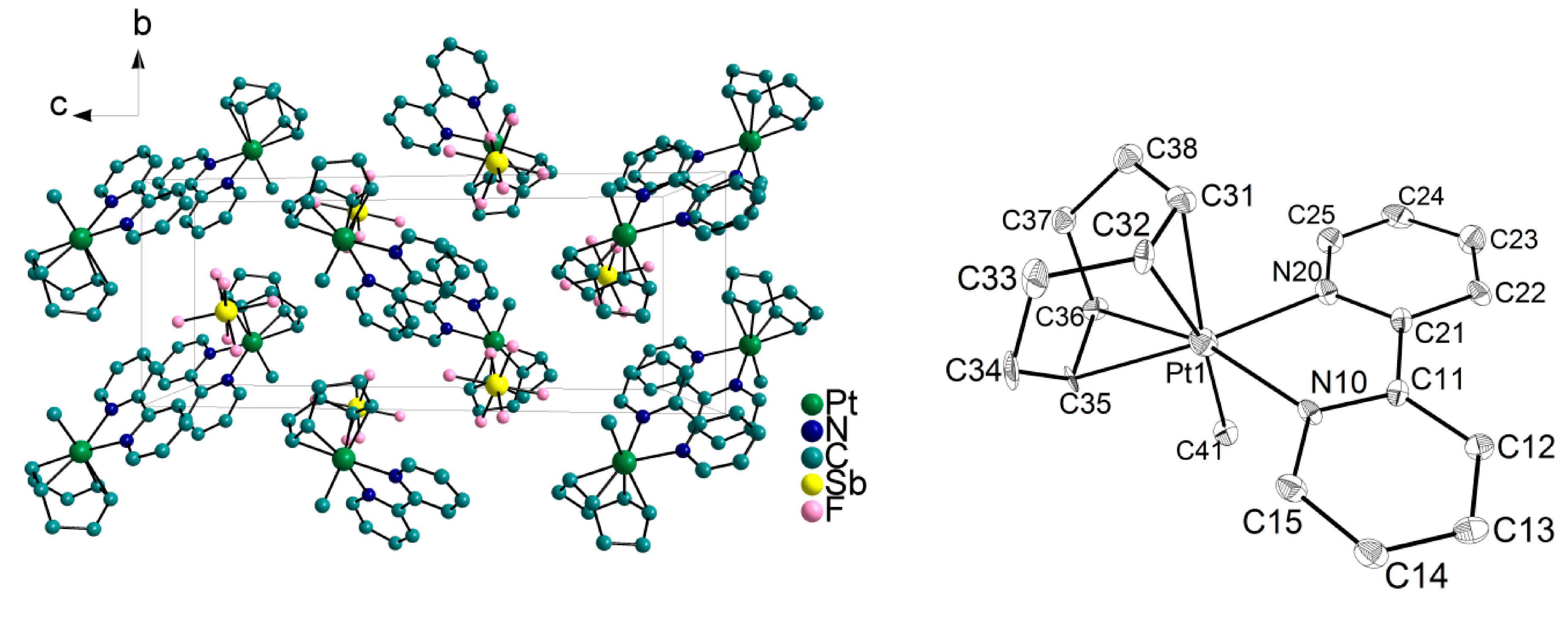
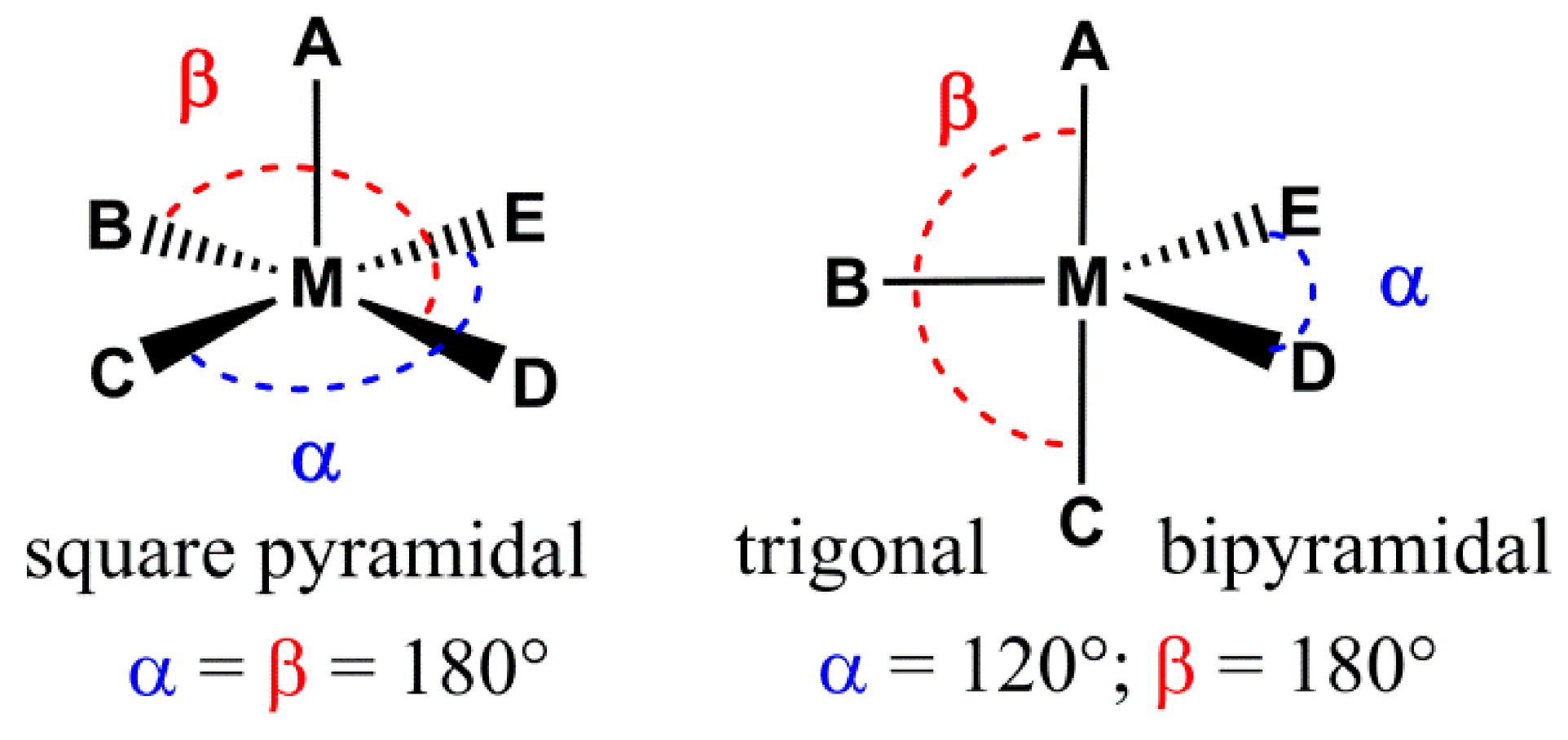

2.3. NMR Spectroscopy
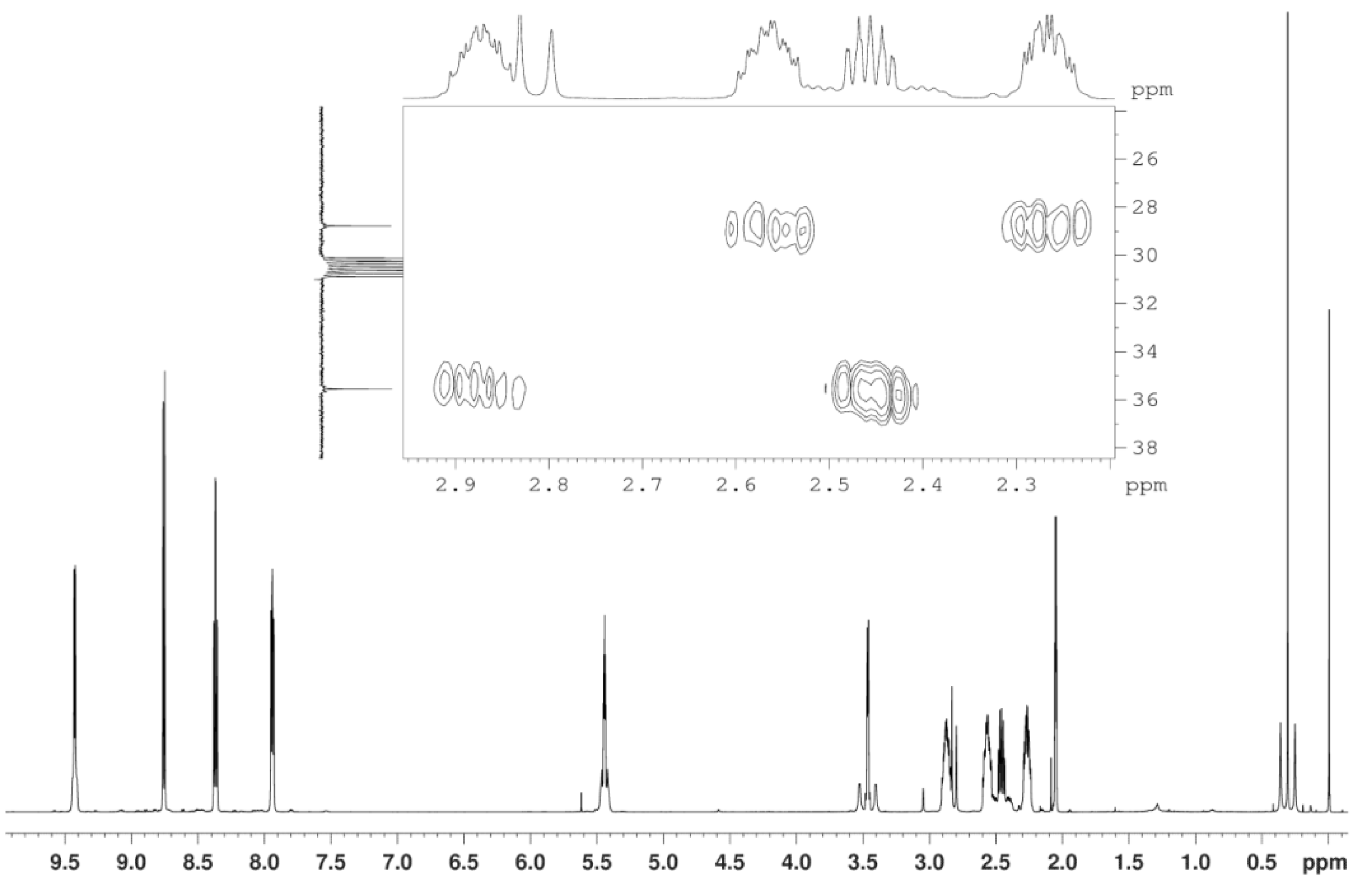
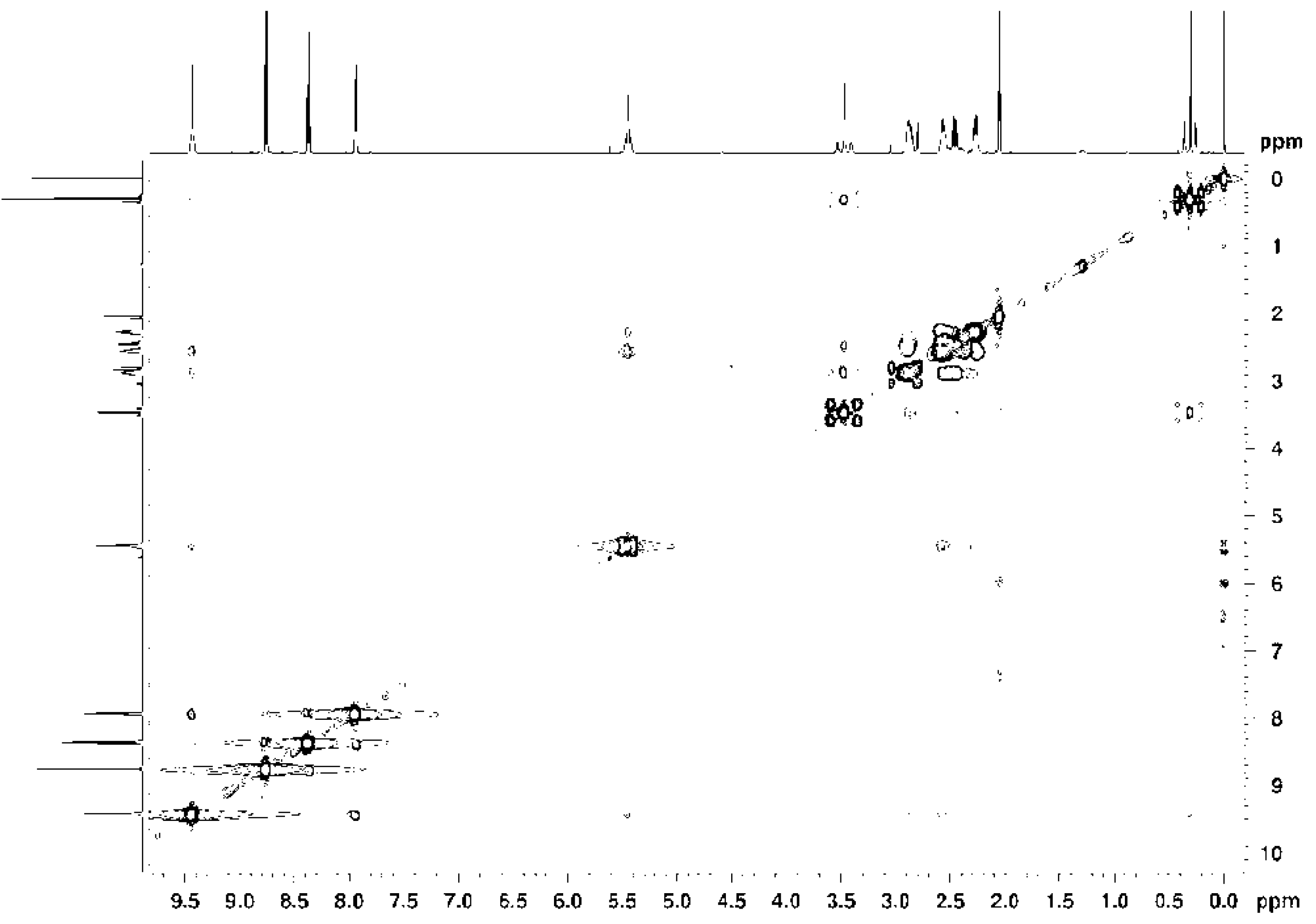

| compound | δ H1,2-cod trans L (equatorial) | 2JPt–H H1,2-cod trans L | δ H5,6-cod trans Me (axial) | 2JPt–H H5,6-cod trans Me | δ Me | 2JPt–H Pt–CH3 | δ 195Pt |
|---|---|---|---|---|---|---|---|
| [Pt(cod)(Me)Cl] | 4.54 | 75 | 5.42 | 36 | 0.78 | 73 | −3501 |
| [Pt(bpy)(cod)(Me)]+ | 3.48 | 74 | 5.46 | 31 | 0.32 | 66 | −3318 |
| [Pt(cod)(Me)(H2O)]+ | 4.96 | 88 | 5.65 | 35 | 0.79 | 66 | −3465 |
| [Pt(cod)(Me)(acetone)]+ b | 4.95 | 91 | 5.65 | 31 | 0.88 | 64 | −3416 |
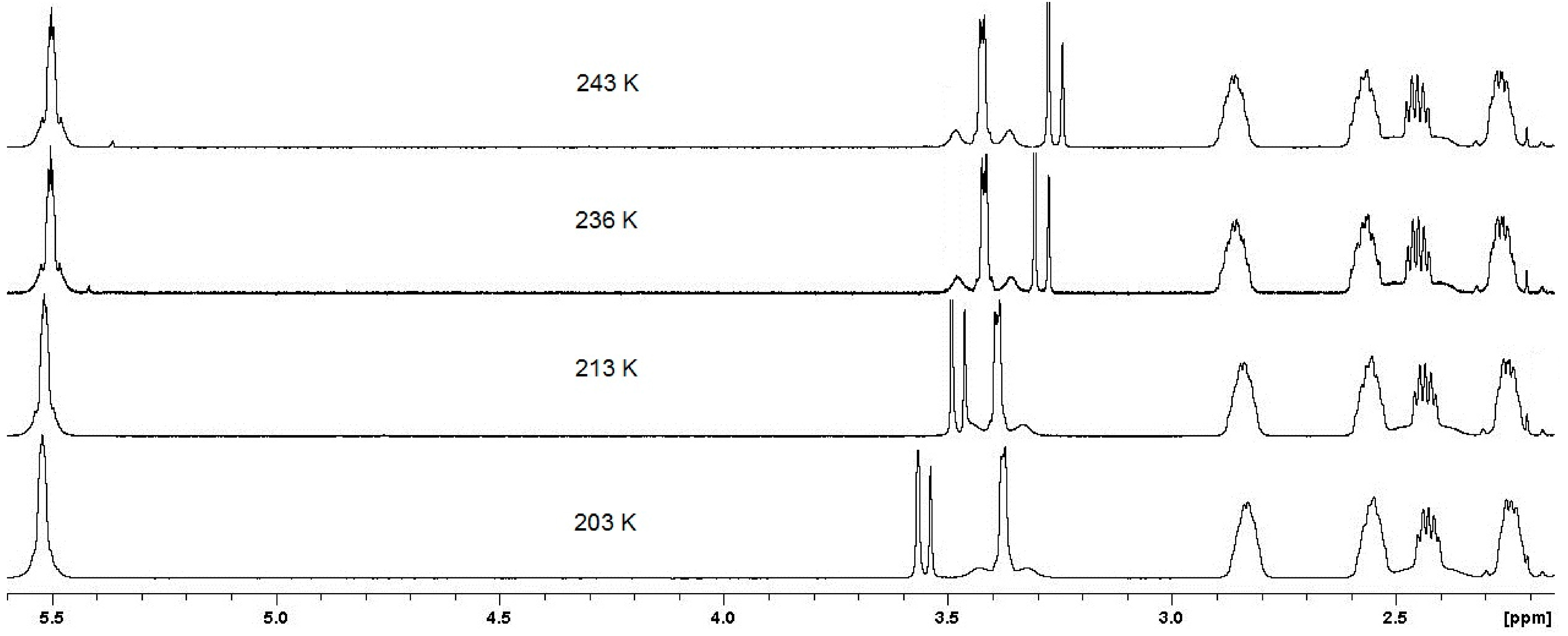
3. Experimental Section
3.1. General
3.2. Instruments
3.3. Reagents
3.4. Synthesis of [Pt(bpy)(cod)(Me)][SbF6]
3.5. Crystal Structure Determination
4. Conclusions
Acknowledgments
Author Contributions
Conflicts of Interest
References
- Steed, J.W.; Atwood, J.L. Supramolecular Chemistry, 2nd ed.; Wiley: Chichester, UK, 2009. [Google Scholar]
- Thorn, D.L.; Hoffmann, R. The Olefin Insertion Reaction. J. Am. Chem. Soc. 1978, 100, 2079–2090. [Google Scholar] [CrossRef]
- Garrou, P.E.; Heck, R. The Mechanism of Carbonylation of Halo(bis-ligand)organoplatinum(II), -palladium(II), and -nickel(II) Complexes. J. Am. Chem. Soc. 1976, 98, 4115–4127. [Google Scholar] [CrossRef]
- Albano, V.G.; Monari, M.; Orabona, I.; Ruffo, F.; Vitagliano, A. Molecular rearrangements in the formation of five-coordinate platinum(II) olefin complexes. Structural and mechanistic aspects. Inorg. Chim. Acta 1997, 265, 35–46. [Google Scholar] [CrossRef]
- Lo, W.K.C.; Cavigliasso, G.; Stranger, R.; Crowley, J.D.; Blackman, A.G. Five-Coordinate [PtII(bipyridine)2(phosphine)]n+ Complexes: Long-Lived Intermediates in Ligand Substitution Reactions of [Pt(bipyridine)2]2+ with Phosphine Ligands. Inorg. Chem. 2014, 53, 3595–3605. [Google Scholar] [CrossRef] [PubMed]
- Fernandez-Anca, D.; Garcia-Seijo, M.I.; Garcia-Fernandez, M.E. Tuneable reactivity with PPh3 and SnX2 of four- and five-coordinate Pd(II) and Pt(II) complexes containing polyphosphines. Dalton. Trans. 2013, 42, 10221–10232. [Google Scholar] [CrossRef] [PubMed]
- Bortoluzzi, M.; Paolucci, G.; Pitteri, B.; Zennaro, P.; Bertolasi, V. New platinum(II) and palladium(II) quinoline-imine-pyridine, quinoline-imine-thiazole and quinoline-imine-imidazole complexes by metal-assisted condensation reactions. J. Organomet. Chem. 2011, 696, 2565–2575. [Google Scholar] [CrossRef]
- Grant, G J.; Benefield, D.A.; VanDerveer, D.G. Thiacrown PtII complexes with group 15 donor ligands: pentacoordination in Pt(II) complexes. Dalton Trans. 2009, 8605–8615. [Google Scholar]
- Momeni, B.Z.; Baleh, L.J.; Hamzeh, S.; Rominger, F. Insertion of SnCl2 into Pt–Cl bonds: synthesis and characterization of four- and five-coordinate trichlorostannylplatinum(II) complexes. J. Coord. Chem. 2007, 60, 285–293. [Google Scholar] [CrossRef]
- West, N.M.; Reinartz, S.; White, P.S.; Templeton, J.L. Carbon Monoxide Promoted Reductive Elimination of Hydrogen from Tp’ Platinum Complexes. J. Am. Chem. Soc. 2006, 128, 2059–2066. [Google Scholar] [CrossRef] [PubMed]
- MacDonald, M.G.; Kostelansky, C.N.; White, P.S.; Templeton, J.L. Ethylene Insertion in Tp’Pt(Ph)(η2-CH2=CH2) and C–H Activation of Ethylbenzene to Form a Platinum(IV) ortho-Metalated Phenethyl Complex. Organometallics 2006, 25, 4560–4570. [Google Scholar] [CrossRef]
- Sagakawa, T.; Ohtsuki, K.; Ishiyma, T.; Ozawa, F. Insertion of Phenylacetylene into Pt(SnMe3)2(PMe2Ph)2. Organometallics 2005, 24, 1670–1677. [Google Scholar] [CrossRef]
- Ara, I.; Fornies, J.; Garcia-Monforte, M.A.; Menjon, B.; Sanz-Carillo, R.M.; Tomas, M.; Tsipis, A.C.; Tsipis, C.A. Synthesis and Characterization of New Five-Coordinate Platinum Nitrosyl Derivatives: Density Functional Theory Study of Their Electronic Structure. Chem. Eur. J. 2003, 9, 4094–4105. [Google Scholar] [CrossRef] [PubMed]
- Otto, S.; Roodt, A. Five co-ordination at platinum(II) in a water soluble tertiary phosphine complex: crystal structure of [Pt(PTA)3(I)2].CH3OH. Inorg. Chem. Commun. 2001, 4, 49–52. [Google Scholar] [CrossRef]
- Benedetti, M.; Antonucci, D.; Girelli, C.R.; Fanizzi, F.P. Hindrance, Donor Ability of MenN^N Chelates and Overall Stability of Pentacoordinate [PtCl2(η2-CH2=CH2)(MenN^N)] Complexes as Observed by η2-Olefin 1JPt,C Modulation: An NMR Study. Eur. J. Inorg. Chem. 2015, 2015, 2308–2316. [Google Scholar] [CrossRef]
- Benedetti, M.; Papadia, P.; Girelli, C.R.; De Castro, F.; Capitelli, F.; Fanizzi, F.P. X-ray structures versus NMR signals in pentacoordinate [PtX2(η2-CH2=CH2)(Me2phen)] (X = Cl, Br, I) complexes. Inorg. Chim. Acta 2015, 428, 8–13. [Google Scholar] [CrossRef]
- Albano, V.G.; De Felice, V.; Monari, M.; Roviello, G.; Ruffo, R. Oxidative Addition of Phenylselenyl Halides to Platinum(0) Complexes: Characterisation and Reactivity of the Products [PtX(SePh)(N,N-chelate)(olefin)] (X = Cl, Br, I). Eur. J. Inorg. Chem. 2005, 416–422. [Google Scholar] [CrossRef]
- De Felice, V.; De Renzi, A.; Fraldi, N.; Roviello, G.; Tuzi, A. C–C coupling of aryl groups and allyl derivatives on Pt(II)-phenanthroline fragments: crystal and molecular structure of the tbp [(η1,η2-2-allyl,5-methyl-phenyl)iodo(1,10-phenanthroline)platinum(II)] complex containing the N–N ligand in axial-equatorial coordination mode. J. Organomet. Chem. 2005, 690, 2035–2043. [Google Scholar] [CrossRef]
- Fanizzi, F.P.; Margiotta, N.; Lanfranchi, M.; Tripicchio, A.; Pacchioni, G.; Natile, G. A Molecular Tool for Measuring the Electron-Acceptor Ability of Ligands from Crystallographic Data. Eur. J. Inorg. Chem. 2004, 1705–1713. [Google Scholar] [CrossRef]
- Albano, V.G.; Monari, M.; Orabona, I.; Panunzi, A.; Ruffo, F. Oxidative Additions of E-E Bonds (E = Chalcogen) to Group 10 Metals: “Tunable” Cleavage of Se-Se Bonds by Pt(0) Complexes. J. Am. Chem. Soc. 2001, 123, 4352–4353. [Google Scholar] [CrossRef] [PubMed]
- Benedetti, M.; Barone, C.R.; Girelli, C.R.; Fanizzi, F.P.; Natile, G.; Maresca, L. H/D exchange at sp3 carbons in the coordination sphere of platinum(II). Dalton Trans. 2014, 3669–3575. [Google Scholar] [CrossRef]
- Plutino, M.R.; Fenech, L.; Stoccoro, S.; Rizzato, S.; Castellano, C.; Albinati, A. Dynamic NMR Study of Ethene Exchange in Cationic CNN-Type Platinum(II) Complexes. Inorg. Chem. 2010, 49, 407–418. [Google Scholar] [CrossRef] [PubMed]
- Shiotsuki, M.; White, P.S.; Brookhart, M.; Templeton, J.L. Mechanistic Studies of Platinum(II)-Catalyzed Ethylene Dimerization: Determination of Barriers to Migratory Insertion in Diimine Pt(II) Hydrido Ethylene and Ethyl Ethylene Intermediates. J. Am. Chem. Soc. 2007, 129, 4058–4067. [Google Scholar] [CrossRef] [PubMed]
- Reinartz, S.; White, P.S.; Brookhart, M.; Templeton, J.L. Acid-Assisted Reductive Elimination as a Route to Platinum(II) Products from Platinum(IV) Tris(pyrazolyl)borate Reagents. Organometallics 2000, 19, 3854–3866. [Google Scholar] [CrossRef]
- Mc Cartney, D.; Guiry, P.J. The asymmetric Heck and related reactions. Chem. Soc. Rev. 2011, 40, 5122–5150. [Google Scholar] [CrossRef] [PubMed]
- Lepski, R.; Lüning, A.; Stirnat, K.; Klein, A. Unexpected formation of [(Me2-Xyl-DAB)Pd(η3−6-methyloct-2-en-1-id)][SbF6] (Me2-Xyl-DAB = 2,3-dimethyl-1,4-bis(2,6-dimethylphenyl)-diazabuta-1,3-diene). J. Organomet. Chem. 2014, 751, 821–825. [Google Scholar] [CrossRef]
- Estevez, L.; Tuxworth, L.W.; Sotiropoulos, J.-M.; Dyer, P.W.; Miqueu, K. Combined DFT and experimental studies of C–C and C–X elimination reactions promoted by a chelating phosphine–alkene ligand: the key role of penta-coordinate PdII. Dalton Trans. 2014, 43, 11165–11179. [Google Scholar] [CrossRef] [PubMed]
- Tuxworth, L.; Baiget, L.; Phanopoulus, A.; Metters, O.J.; Batsanov, A.S.; Fox, M.A.; Howard, J.A.K.; Dyer, P.W. Phosphine–alkene ligand-mediated alkyl–alkyl and alkyl–halide elimination processes from palladium(II). Chem. Commun. 2012, 48, 10413–10415. [Google Scholar] [CrossRef]
- McDonald, R.I.; Liu, G.; Stahl, S.S. Palladium(II)-Catalyzed Alkene Functionalization via Nucleopalladation: Stereochemical Pathways and Enantioselective Catalytic Applications. Chem. Rev. 2011, 111, 2981–3019. [Google Scholar] [CrossRef] [PubMed]
- Jira, R. Acetaldehyde from ethylene—A Retrospective on the Discovery of the Wacker Process. Angew. Chem. Int. Ed. 2009, 48, 9034–9037. [Google Scholar] [CrossRef]
- Keith, J.A.; Henry, P.M. The Mechanism of the Wacker Reaction: A Tale of Two Hydroxypalladations. Angew. Chem. Int. Ed. 2009, 48, 9038–9049. [Google Scholar] [CrossRef]
- Hintermann, L. Wacker Oxidation. In Handbook of C–H Transformations; Wiley-VCH: Weinheim, Germany, 2005; Volume 1, pp. 287–301. [Google Scholar]
- Zeise, W.C. Von der Wirkung zwischen Platinchlorid und Alkohol, und von den dabei entstehenden neuen Substanzen. Ann. Phys. Chem. 1831, 97, 497–541. (In Germany) [Google Scholar] [CrossRef]
- Hunt, L.B. The First Organometallic Compounds. Plat. Met. Rev. 1984, 28, 76–83. [Google Scholar]
- Nyholm, R.S. Synthesis, Structure and Reactions of Chelate Metal-Olefin Complexes. Pure Appl. Chem. 1971, 27, 127–144. [Google Scholar] [CrossRef]
- Nyholm, R.S. Electron Configuration and Structure of Transition-Metal Complexes. Proc. Chem. Soc. 1961, 273–296. [Google Scholar]
- Benedetti, M.; Barone, C.R.; Antonucci, D.; Vechio, V.M.; Ienco, A.; Maresca, L.; Natile, G.; Fanizzi, F.P. Modulation of properties in analogues of Zeise’s anion on changing the ligand trans to ethene. X-ray crystal structures of trans-[PtCl2(OH)(η2-C2H4)]− and trans-[PtCl2(η1-CH2NO2)(η2-C2H4)]−. Dalton Trans. 2012, 41, 3014–3021. [Google Scholar] [CrossRef] [PubMed]
- Chock, P.B.; Halpern, J.; Paulik, F.E.; Shupack, S.I.; DeAngelis, T.P. Potassium Trichloro(ethene)palatinate(II) (Zeise’s salt). Inorg. Synth. 1990, 28, 349–351. [Google Scholar]
- Love, R.A.; Koetzle, T.F.; Bau, R. Neutron Diffraction Study of the Structure of Zeise’s Salt, KPtCl3(C2H4) H2O. Inorg. Chem. 1975, 14, 2653–2657. [Google Scholar] [CrossRef]
- Black, M.; Mais, R.H.B.; Owston, P.G. The Crystal and Molecular Structure of Zeise's Salt, KPtCl3 C2H4.H2O. Acta Crystallogr. B 1969, 25, 1753–1759. [Google Scholar] [CrossRef]
- Birnbaum, K. Ueber die Einwirkung der schwefligen Saure auf Platinchlorid. Ann. Chem. Pharm. 1869, 152, 137–147. [Google Scholar] [CrossRef]
- Benedetti, M.; Antonucci, D.; de Pascali, S.A.; Ciccarella, G.; Fanizzi, F.P. Alkyl-vinyl-ethers from alcoholic substrates and the Zeise’s salt, via square planar [PtCl(N^N)(η1-CH2CH2OR)] complexes. J. Organomet. Chem. 2012, 714, 104–108. [Google Scholar] [CrossRef]
- Benedetti, M.; Fanizzi, F.P.; Maresca, L.; Natile, G. The unexpected reactivity of Zeise’s anion in strong basic medium discloses new substitution patterns at the platinum centre. Chem. Commun. 2006, 1118–1120. [Google Scholar] [CrossRef]
- Klein, A.; Klinkhammer, K.-W.; Scheiring, T. Cyclooctadienemethylplatinum complexes: synthesis, reactivity, molecular structure and spectroscopic properties of the organometallic hydroxoplatinum(II) complex [(COD)PtMe(OH)]. J. Organomet. Chem. 1999, 592, 128–135. [Google Scholar] [CrossRef]
- Rooke, D.A.; Menard, Z.A.; Ferreira, E.M. An analysis of the influences dictating regioselectivity in platinumcatalyzed hydrosilylations of internal alkynes. Tetrahedron 2014, 70, 4232–4244. [Google Scholar] [CrossRef]
- Dub, P.A.; Daran, J.-C.; Levin, V.A.; Belkova, N.V.; Shubina, E.S.; Poli, R. Modeling the platinum-catalyzed intermolecular hydroamination of ethylene: The nucleophilic addition of HNEt2 to coordinated ethylene in trans-PtBr2(C2H4)(HNEt2). J. Organomet. Chem. 2011, 696, 1174–1183. [Google Scholar] [CrossRef]
- Karshtedt, D.; Bell, A.T.; Don Tilley, T. Platinum-Based Catalysts for the Hydroamination of Olefins with Sulfonamides and Weakly Basic Anilines. J. Am. Chem. Soc. 2005, 127, 12640–12646. [Google Scholar] [CrossRef] [PubMed]
- Benedetti, M.; Antonucci, D.; Girelli, C.R.; Capitelli, F.; Fanizzi, F.P. Reactivity of [PtCl(η2-C2H4)(N-N)]+, N-N = diimine ligand, with phenol derivatives and first comparison between single crystal X-ray structures of syn- and anti-[Pt(N-N)(phenolate)2] rotamers in the solid state. Inorg. Chim. Acta 2014, 409, 427–432. [Google Scholar] [CrossRef]
- Benedetti, M.; Girelli, C.R.; Antonucci, D.; De Pascali, S.A.; Fanizzi, F.P. New method for the synthesis of [PtCl{η1-CH2C(O)R}(N-N)] ketonyl derivatives starting from the Zeise’s salt. Inorg. Chim. Acta 2014, 413, 109–114. [Google Scholar] [CrossRef]
- Benedetti, M.; Girelli, C.R.; Antonucci, D.; Fanizzi, F.P. [PtCl(η1-CH2–CH2OR)(N^N)] and [PtCl(η2-CH2=CH2)(N^N)]+, N^N = dinitrogen ligand, complexes. Sterical and electronic effects evidenced by NMR analysis. J. Organomet. Chem. 2014, 771, 40–46. [Google Scholar] [CrossRef]
- Benedetti, M.; Antonucci, D.; de Pascali, S.A.; Girelli, C.R.; Fanizzi, F.P. Pentacoordinate [PtCl2(η2-C2H4)(N-N’)] complexes with asymmetrically hindered nitrogen donor chelates. Stereospecific synthesis of syn- and anti-[PtCl(η1-CH2CH2OMe)(Mebpy)]. J. Organomet. Chem. 2012, 714, 60–66. [Google Scholar] [CrossRef]
- Barone, C.R.; Benedetti, M.; Vecchio, V.M.; Fanizzi, F.P.; Maresca, L.; Natile, G. New chemistry of olefin complexes of platinum(II) unravelled by basic conditions: synthesis and properties of elusive cationic species. Dalton Trans. 2008, 5313–5322. [Google Scholar] [CrossRef]
- Albano, V.G.; Natile, G.; Panunzi, A. Five-coordinate platinum(II). Coord. Chem. Rev. 1994, 133, 67–114. [Google Scholar] [CrossRef]
- Maresca, L.; Natile, G. Five-Coordination in Platinum(II) and Palladium(II) Chemistry. Comments Inorg. Chem. 1993, 16, 95–112. [Google Scholar] [CrossRef]
- Fanizzi, F.P.; Maresca, L.; Natile, G.; Lanfranchi, M.; Tiripicchio, A.; Pacchioni, G. Five-coordination in Platinum(II) Species: When and Why. J. Chem. Soc. Chem. Commun. 1992, 333–335. [Google Scholar] [CrossRef]
- Margiotta, N.; Bertolasi, V.; Capitelli, F.; Maresca, L.; Moliterni, A.G.G.; Vizza, F.; Natile, G. Influence of steric and electronic factors in the stabilization of five-coordinate ethylene complexes of platinum(II): X-ray crystal structure of [PtCl2(2,9-dimethyl-1,10-phenanthroline-5,6-dione)]. Inorg. Chim. Acta 2004, 357, 149–158. [Google Scholar] [CrossRef]
- De Felice, V.; De Renzi, A.; Ferrara, M.L.; Panunzi, A. Reaction products of CO with square-planar platinum(II)-(N,N-chelate) complexes: synthesis and reactivity. J. Organomet. Chem. 1996, 513, 97–104. [Google Scholar] [CrossRef]
- Bartolucci, S.; Carpinelli, P.; De Felice, V.; Giovannitti, B.; De Renzi, A. Five-coordinate platinum(II) complexes containing substituted olefins: synthesis and cytostatic activity. Inorg. Chim. Acta 1992, 197, 51–57. [Google Scholar] [CrossRef]
- Fanizzi, F.P.; Intini, F.P.; Maresca, L.; Natile, G.; Lanfranchi, M.; Tiripicchio, A. Four- versus Five-co-ordination in Palladium(II) and Platinum(II) Complexes containing 2,9-Dimethyl-l,10- phenanthroline (dmphen). Crystal Structures of [PtCl2(dmphen)] and [Pt(η2-C2H4)Cl2(dmphen)]. J. Chem. Soc., Dalton Trans. 1991, 1007–1015. [Google Scholar] [CrossRef]
- Natile, G.; Maresca, L.; Cattalini, L.; Belluco, U.; Uguagliati, P.; Croatto, U. Decomposition of [Pt(C2H4)Cl2(bipyridyl)] to [PtCl2(bipyridyl)] and Ethylene in Different Solvents. Inorg. Chim. Acta 1976, 20, 49–52. [Google Scholar] [CrossRef]
- De Pascali, S.A.; Migoni, D.; Papadia, P.; Muscella, A.; Marsigliante, S.; Ciccarese, A.; Fanizzi, F.P. New water-soluble platinum(II) phenanthroline complexes tested as cisplatin analogues: First-time comparison of cytotoxic activity between analogous four- and five-coordinate species. Dalton Trans. 2006, 5077–5087. [Google Scholar] [CrossRef]
- Fanizzi, F.P.; Maresca, L.; Pacifico, C.; Natile, G.; Lanfranchi, M.; Tiripicchio, A. Halogenation of Alkenes in Five-Coordinate Platinum(II) Complexes—Route to Stable (β-Haloalkyl)platinum(IV) Species. Eur. J. Inorg. Chem. 1999, 1351–1358. [Google Scholar]
- Fanizzi, F.P.; Natile, G.; Lanfranchi, M.; Tiripicchio, A.; Pacchioni, G. Five-coordinate platinum(II) alkyne complexes: synthesis, ab initio calculations and crystal and molecular structure of [PtI2(Me2phen)(η3-PhC≡CPh)].CHCl3. Inorg. Chim. Acta 1998, 275–276, 500–509. [Google Scholar] [CrossRef]
- Fanizzi, F.P.; Natile, G.; Lanfranchi, M.; Tiripicchio, A.; Laschi, F.; Zanello, P. Steric Crowding and Redox Reactivity in Platinum(II) and Platinum(IV) Complexes Containing Substituted 1,10-Phenanthrolines. Inorg. Chem. 1996, 35, 3173–3182. [Google Scholar] [CrossRef] [PubMed]
- Clark, R.J.H.; Fanizzi, F.P.; Natile, G.; Pacifico, C.; van Rooyen, C.G.; Tocher, D.A. Steric constraints and addition reactions in platinum(II) complexes containing 2,9-dimethyl-l,10-phenanthroline(Me2-phen). X-ray crystal structures of [PtBr2(Me2-phen)] and [PtI2(Me2-phen)]. Inorg. Chim. Acta 1995, 235, 205–213. [Google Scholar] [CrossRef]
- Centore, R.; Roviello, G.; Tuzi, A. Two geometrical isomers of the five-coordinate Platinum(II) complex [PtBr(SePh)(2,9-dimethyl-1,10-phenanthroline)(dimethylmaleate)]. Inorg. Chim. Acta 2005, 358, 2112–2116. [Google Scholar] [CrossRef]
- De Felice, V.; Giordano, F.; Orabona, I.; Tesauro, D.; Vitagliano, A. Stabilization of unstable unsaturated molecules in five-coordinate TBP complexes of Pt(II): enol, diol and dialdehyde derivatives. J. Organomet. Chem. 2001, 622, 242–250. [Google Scholar] [CrossRef]
- Albano, V.G.; Castallari, C.; Monari, M.; De Felice, V.; Panunzi, A.; Ruffo, F. Synthesis and Characterization of Five-Coordinate [PtCl(L)(N-N)(olefin)]+ Complexes. Molecular Structure of [PtCl(pyridine)(2,9-dimethyl-l,10-phenanthroline)(ethylene)](CF3SO3). Organometallics 1992, 11, 3665–3669. [Google Scholar] [CrossRef]
- Sanchez, A.; Castellari, C.; Panunzi, A.; Vitagliano, A.; De Felice, V. New cationic five-coordinate monoolefin in hydrocarbyl complexes of platinum(II). J. Organomet. Chem. 1990, 388, 243–252. [Google Scholar] [CrossRef]
- Gund, A.; Keppler, B.K.; Nuber, B. Five-Coordinate Platinum Olefin Complexes: Synthesis, lH NMR Investigations, and Crystal Structure of a Platinum η2-Ethylene Crown Ether Complex. Inorg. Chem. 1995, 34, 2788–2790. [Google Scholar] [CrossRef]
- Van der Poel, H.; van Koten, G.; Kokkes, M.; Stam, C.H. Five-Coordinate [PtIICl2(η2-olefin)L2] (L2 = σ,σN,N’-Bonded α-Diimine or N,N'-Disubstituted 1,2-Diaminoethane) Complexes. Solution Conformation, η2-Olefin Rotational Barriers (NMR), and the X-ray Molecular Structure of [PtCl2(η2-styrene) (t-Bu-N=CHCH=N-t-Bu)]. Inorg. Chem. 1981, 20, 2941–2950. [Google Scholar] [CrossRef]
- Di Bianca, F.; Bandoli, G.; Dolmella, A.; Antonaroli, S.; Crociani, B. Five-coordinate complexes of palladium(II) and platinum(II) with α-diimine and 1,5-cyclooctadiene ligands. J. Chem. Soc. Dalton Trans. 2002, 212–217. [Google Scholar] [CrossRef]
- Burger, P.; Baumeister, J.M. Transition metal complexes with sterically demanding ligands. I. Synthesis and X-ray crystal structure of 1,5-cyclooctadiene palladium methyl triflate, (COD)Pd(Me)(OTf) and its cationic penta-coordinate adducts with sterically demanding 2,9-diaryl-substituted 1,10-phenanthroline ligands. J. Organomet. Chem. 1999, 575, 214–222. [Google Scholar] [CrossRef]
- Albano, V.G.; Demartin, F.; De Felice, V.; Morelli, G.; Vitagliano, A. Five-coordinate diene complexes of platinum(II). Gazz. Chim. Ital. 1987, 117, 437–441. [Google Scholar]
- Rotondo, E.; Tresoldi, G.; Faraone, F.; Pietropaolo, R. Displacement of Dienes from Planar Complexes. 1. Reaction of (1,5-Cyclooctadiene)dichloropalladium(II) with 2,2’-Bipyridyl. Inorg. Chem. 1976, 15, 2102–2107. [Google Scholar] [CrossRef]
- De Felice, V.; Cucciolito, M.E.; De Renzi, A.; Ruffo, F.; Tesauro, D. Cationic Platinum(II)-or Palladium(II)-carbyl complexes and unsaturated substrates: a facile way to C–C bond formation. J. Organomet. Chem. 1995, 493, 1–11. [Google Scholar] [CrossRef]
- Pietropaolo, R.; Cusmano, F.; Rotondo, E.; Spadaro, A. Preparation and Reactions of Palladium(II) and Platinum(II) Dienyl Complexes. J. Organomet. Chem. 1978, 155, 117–122. [Google Scholar] [CrossRef]
- Haszeldine, R.N.; Parish, R.V.; Robbins, D.W. Reactions involving Transition Metals. Part XI. Reactions of Nucleophiles with Dieneplatinum Complexes. J. Chem. Soc., Dalton Trans. 1976, 2355–2363. [Google Scholar] [CrossRef]
- Overbosch, P.; van Koten, G.; Grove, D.M.; Spek, A.L.; Duisenberg, A.J.M. (Tetraazabutadiene)platinum Complexes. X-ray Crystal and Molecular Structure of the Triethylphosphine Nucleophilic Addition Product [Pt(1,4-(4-NO2C6H4)2N4)(CHC(PEt3)H (CH2)2CH=CHCH2CH2)(PEt3)], a Novel Five-Coordinate Blue Mononuclear Platinum Species. Inorg. Chem. 1982, 21, 3253–3260. [Google Scholar] [CrossRef]
- Suzaki, Y.; Osakada, K. Formation, Dynamic Behavior, and Chemical Transformation of Pt Complexes with a Rotaxane-like Structure. Chem. Asian J. 2006, 1, 331–343. [Google Scholar] [CrossRef] [PubMed]
- Kretschmer, M.; Pregosin, P.S.; Rüegger, H. Synthesis, 119Sn, 13C and 195Pt NMR Studies of Five-Coordinate Rhodium(I), Iridium(I) and Platinum(II) Complexes Containing Three Trichlorostannate Ligands. J. Organomet. Chem. 1983, 241, 87–98. [Google Scholar] [CrossRef]
- Mink, L.; Rettig, M.F.; Wing, R.M. Trigonal-bipyramidal five-coordinate trisolefin complexes of platinum(II). J. Am. Chem. Soc. 1991, 113, 2065–2071. [Google Scholar] [CrossRef]
- Herberhold, M.; Schmalz, T.; Milius, W.; Wrackmeyer, B. Tri(1-cyclohepta-2,4,6-trienyl)-phosphine, P(C7H7)3, as a tripodal tetradentate ligand in cationic, five-coordinate complexes of platinum(II) and palladium(II). Z. Naturforsch. B 2002, 57, 255–258. [Google Scholar]
- Clark, H.C.; von Werner, K. cis-π-Acetylenic Methylplatinum(II) Complexes. J. Organomet. Chem. 1975, 101, 347–358. [Google Scholar] [CrossRef]
- Mikola, M.; Klika, K.D.; Hakala, A.; Arpalahti, J. Substitution Reactions of Platinum(II)-Nucleobase Complexes by Associative Mechanism Involving Pseudorotation of the Five-Coordinate Intermediate. Inorg. Chem. 1999, 38, 571–578. [Google Scholar] [CrossRef] [PubMed]
- Mikola, M.; Vihanto, J.; Arpalahti, J. Dissociation of Platinum(II) Nucleobase Complexes-Evidence for a Three-path Mechanism via a Five-coordinate Intermediate. J. Chem. Soc., Chem. Commun. 1995, 1759–1760. [Google Scholar] [CrossRef]
- Klein, A.; Lepski, R. 2,2’-Bipyridine as both Bridging and Terminal Ligand in the Binuclear Palladium Complex [(μ-η1,η1-bpy){Pd(Me)(bpy)}2](SbF6)2—Structure and Spectroscopic Properties. Z. Anorg. Allgem. Chem. 2009, 635, 878–884. [Google Scholar] [CrossRef]
- Crans, D.C.; Tarlton, M.L.; McLauchlan, C.C. Trigonal Bipyramidal or Square Pyramidal Coordination Geometry? Investigating the Most Potent Geometry for Vanadium Phosphatase Inhibitors. Eur. J. Inorg. Chem. 2014, 4450–4468. [Google Scholar] [CrossRef]
- Addison, A.W.; Rao, T.N.; Reedijk, J.; van Rijn, J.; Verschoor, G.C. Synthesis, Structure, and Spectroscopic Properties of Copper(II) Compounds containing Nitrogen-Sulphur Donor Ligands; the Crystal and Molecular Structure of Aqua[l,7-bis(N-methylbenzimidazol-2’-yl)-2,6-dithiaheptane]copper(II) Perchlorate. Dalton Trans. 1984, 1349–1356. [Google Scholar] [CrossRef]
- Corona-Rodriguez, M.; Hernandez-Ortega, S.; Valdes-Martinez, J.; Morales-Morales, D. [2,2’-Bipyridyl]platinum(II) Complexes with Fluorinated Benzenethiolate Ligands: Synthesis and Structural Elucidation. Supramol. Chem. 2007, 19, 579–585. [Google Scholar] [CrossRef]
- Klein, A.; van Slageren, J.; Zalis, S. Co-Ligand Involvement in Ground and Excited States of Electron-Rich (Polypyridyl)PtII Complexes. Eur. J. Inorg. Chem. 2003, 1927–1938. [Google Scholar]
- Textor, M.; Oswald, H.R. Röntgenographische und spektroskopische Untersuchungen an zwei Modifikationen von Dichloro-2,2’-dipyridyl-platin(II). Z. Anorg. Allgem. Chem. 1974, 407, 244–256. [Google Scholar] [CrossRef]
- Osborn, R.S.; Rogers, D. Crystal Structure of the Red Form of 2,2’-Bipyridyldichloroplatinum(II). Dalton Trans. 1974, 1002–1004. [Google Scholar] [CrossRef]
- Lüning, A.; Neugebauer, M.; Lingen, V.; Krest, A.; Stirnat, K.; Deacon, G.B.; Drago, P.R.; Ott, I.; Schur, J.; Pantenburg, I.; Meyer, G.; Klein, A. Platinum Diolefin Complexes—Synthesis, Structures, and Cytotoxicity. Eur. J. Inorg. Chem. 2015, 226–239. [Google Scholar] [CrossRef]
- Klein, A.; Lüning, A.; Ott, I.; Hamel, L.; Neugebauer, M.; Butsch, K.; Lingen, V.; Heinrich, F.; Elmas, S. Organometallic palladium and platinum complexes with strongly donating alkyl coligands—Synthesis, structures, chemical and cytotoxic properties. J. Organomet. Chem. 2010, 695, 1898–1905. [Google Scholar] [CrossRef]
- Butsch, K.; Elmas, S.; Sen Gupta, N.; Gust, R.; Heinrich, F.; Klein, A.; von Mering, Y.; Neugebauer, M.; Ott, I.; Schäfer, M.; Scherer, H.; Schurr, T. Organoplatinum(II) and -palladium(II) Complexes of Nucleobases and Their Derivatives. Organometallics 2009, 28, 3906–3915. [Google Scholar] [CrossRef]
- Keefer, C.E.; Bereman, R.D.; Purrington, S.T.; Knight, B.W.; Boyle, P.D. The 195Pt NMR of L2Pt(1,2-dithiolene) Complexes. Inorg. Chem. 1999, 38, 2294–2302. [Google Scholar] [CrossRef]
- Rivera, B.; Torrens, H.; Bernès, S. [(1,2:5,6-η)-Cycloocta-1,5-diene]bis[2,3,5,6-tetrafluoro-4-(trifluoromethyl)benzenethiolato]platinum(II). Acta Cryst. E 2006, 62, m3287–m3288. [Google Scholar] [CrossRef]
- Osakada, K.; Hosoda, T.; Yamamoto, T. Kinetic Results and Reaction Pathways of Intermolecular Thiolato Ligand Migration between Titanocene Complexes and from Cp2TiX(SAr) (X = Cl, SAr) to PtCl(Me)(cod) (cod = η2,η2-1,5-Cyclooctadiene). Bull. Chem. Soc. Jpn. 2000, 73, 923–930. [Google Scholar] [CrossRef]
- Syed, A.; Stevens, E.D.; Cruz, S.G. Reexamination of the σ Bonding in Dichloro(cycloocta-1,5-diene)platinum. Inorg. Chem. 1984, 23, 3673–3674. [Google Scholar] [CrossRef]
- Otto, S. Structure and solution behaviour of cyclooctadiene complexes of platinum(II). Inorg. Chim. Acta 2010, 363, 3316–3320. [Google Scholar] [CrossRef]
- Suzaki, Y.; Osakada, K. Transmetalation of Phenylplatinum(II) Complex. Isolation and Characterization of a Dinuclear Intermediate in Intermolecular Phenyl Ligand Transfer. Organometallics 2004, 23, 5081–5084. [Google Scholar] [CrossRef]
- Smith, D.C., Jr.; Haar, C.M.; Stevens, E.D.; Nolan, S.P. Synthetic, Structural, and Solution Calorimetric Studies of Pt(CH3)2(PP) Complexes. Organometallics 2000, 19, 1427–1433. [Google Scholar] [CrossRef]
- Wyrwa, R.; Poppitz, W.; Görls, H. Mass Spectrometric and X-Ray Studies on Complexes of the Type (COD)PtX2 (X = Cl, Br, I, CH3, CH2CMe3, CH2SiMe3). Z. Anorg. Allgem. Chem. 1997, 623, 649–653. [Google Scholar] [CrossRef]
- Gay, I.D.; Young, G.B. Chemical Shift Anisotropy of Organometallic Carbon. Organometallics 1996, 15, 2264–2269. [Google Scholar] [CrossRef]
- Enders, M.; Görling, B.; Braun, A.B.; Seltenreich, J.E.; Reichenbach, L.F.; Rissanen, K.; Nieger, M.; Luy, B.; Schepers, U.; Bräse, S. Cytotoxicity and NMR Studies of Platinum Complexes with Cyclooctadiene Ligands. Organometallics 2014, 33, 4027–4034. [Google Scholar] [CrossRef]
- Gottlieb, H.E.; Kotlyar, V.; Nudelman, A. NMR Chemical Shifts of Common Laboratory Solvents as Trace Impurities. J. Org. Chem. 1997, 62, 7512–7515. [Google Scholar] [CrossRef] [PubMed]
- Altomare, A.; Cascarano, G.; Giacovazzo, C.; Guagliardi, A.; Burla, M.C.; Polidori, G.; Camalli, M. Sir-92; A Program for Automatic Solution and Refinement of Crystal Structures; CNR Institute of Crystallography: Bari, Italy, 1994. [Google Scholar]
- Farrugia, L.J. WinGX and ORTEP for Windows: an update. J. Appl. Cryst. 2012, 45, 849–854. [Google Scholar] [CrossRef]
- Sheldrick, G.M. SHELXL-2013; Program for the Refinement of Crystal Structures; University of Göttingen: Germany, 2008. [Google Scholar]
© 2015 by the authors; licensee MDPI, Basel, Switzerland. This article is an open access article distributed under the terms and conditions of the Creative Commons Attribution license (http://creativecommons.org/licenses/by/4.0/).
Share and Cite
Klein, A.; Neugebauer, M.; Krest, A.; Lüning, A.; Garbe, S.; Arefyeva, N.; Schlörer, N. Five Coordinate Platinum(II) in [Pt(bpy)(cod)(Me)][SbF6]: A Structural and Spectroscopic Study. Inorganics 2015, 3, 118-138. https://doi.org/10.3390/inorganics3020118
Klein A, Neugebauer M, Krest A, Lüning A, Garbe S, Arefyeva N, Schlörer N. Five Coordinate Platinum(II) in [Pt(bpy)(cod)(Me)][SbF6]: A Structural and Spectroscopic Study. Inorganics. 2015; 3(2):118-138. https://doi.org/10.3390/inorganics3020118
Chicago/Turabian StyleKlein, Axel, Michael Neugebauer, Alexander Krest, Anna Lüning, Simon Garbe, Natalia Arefyeva, and Nils Schlörer. 2015. "Five Coordinate Platinum(II) in [Pt(bpy)(cod)(Me)][SbF6]: A Structural and Spectroscopic Study" Inorganics 3, no. 2: 118-138. https://doi.org/10.3390/inorganics3020118
APA StyleKlein, A., Neugebauer, M., Krest, A., Lüning, A., Garbe, S., Arefyeva, N., & Schlörer, N. (2015). Five Coordinate Platinum(II) in [Pt(bpy)(cod)(Me)][SbF6]: A Structural and Spectroscopic Study. Inorganics, 3(2), 118-138. https://doi.org/10.3390/inorganics3020118







